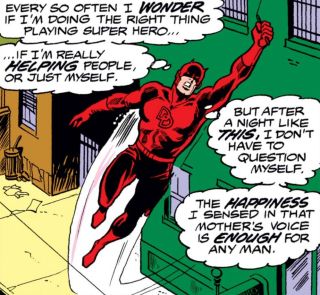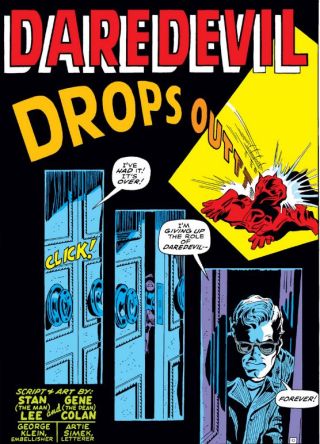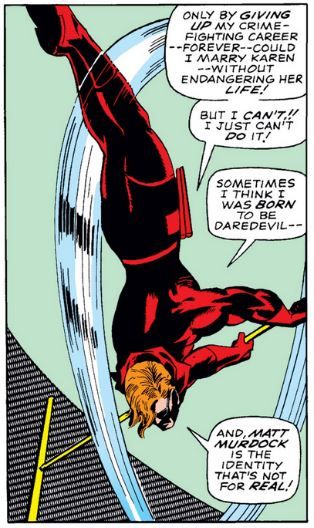Identity
Matt Murdock's Identity Crisis: To Be or Not To Be Daredevil
His crisis may parallel the multiple roles we play.
Updated December 29, 2023 Reviewed by Jessica Schrader
Key points
- Matt Murdock is a man of conflicts, resulting in an ongoing cycle of quitting and resuming being Daredevil.
- Sometimes this goes as far as to make him doubt which identity, Matt Murdock or Daredevil, is his true self.
- We all have different selves in the sense of playing various roles, but we integrate them through our values.
As we saw in the last two posts, Matt Murdock is often unsure of the value he makes as Daredevil, with his responsibility to use his abilities and the good he does in saving lives in constant conflict with his desire for a personal life and the fear of putting his loved ones in danger.1
Add to this the fact that, unlike most superheroes, Matt really loves being Daredevil! In a very early issue, he compared himself to Peter Pan, asking himself, “Do I really do this to help mankind… or am I just a showoff who never grew up?!!” (Daredevil #9, August 1965). Later, when he wondered why he preferred being Daredevil to Matt Murdock, even if it meant he couldn’t be with his love Karen Page, he realized that “I wanted the excitement—the glamour—the adventure of a superhero’s life!” (Daredevil #49, February 1969).

This all contributes to his chronic indecisiveness about why he continues as Daredevil. After one successful case in which he returned a sick child to his mother, he both asks and answers the question:
"Every so often I wonder if I’m doing the right thing playing super hero… if I’m really helping people, or just myself. But after a night like this, I don’t have to question myself. The happiness I sensed in that mother’s voice is enough for any man." (Daredevil #139, November 1976)
Another time he faced the conflict between being Daredevil and being with Karen, he first sided with the former, telling himself, “There’s something about being a free-wheeling superhero… something that gets in your blood!” (Daredevil #61, February 1971). But two issues later, he changed his mind, thinking, “Karen’s more important to me than life itself—let alone my double-life as a swashbuckling showoff!” (Daredevil #63, April 1970).
Should I Stay or Should I Go?
This relentless doubt often results in Matt seriously questioning whether to carry on as Daredevil at all. The very first time he acted on this, Matt invented a new identity, his brother “Mike," to protect his secret identity; after a while, he claimed that Mike was actually Daredevil and then faked the deaths of both of them.1 Now free to enjoy the simple life with Karen, Matt thought to himself, “I’m beginning to think I should have killed off my Daredevil identity long ago!” But you can guess what happened next: After a threat compelled him to don his costume again, he realized that “so long as Matt Murdock lives… there will always be… a Daredevil!” (Daredevil #42, July 1968).

Soon afterward, though, after alienating both Karen and his best friend Foggy, Matt proclaimed (to no one in particular):
"I’ve had it! It’s over! I’m giving up the role of Daredevil—forever! Daredevil! He’s already caused me to lose the girl I love—and my best friend, as well! It’s something I should have done—a long time ago!" Daredevil #49 (February 1969)
In the same issue, he also cursed the costume as a symbol of his double life, acknowledging the work he’s put into making it “a symbol of courage and skill” before bemoaning what it’s cost him:
"Big deal! It can’t put its arms around me—or kiss me goodnight! Or set me on fire, like the sound of Karen’s voice—or the touch of her lips! All it can do—all it’s ever done—is keep me from her! But not any longer!"
Nonetheless, as we saw in the first post, by the end of the issue he comes to appreciate the value of Daredevil again (after seeing Willie Lincoln again) and rescinds his resignation.
But he’s not done! Matt promised to quit again two issues later, but another two issues later he introduced a twist, motivated by the discovery of his secret identity by the villain Starr Saxon. Matt remembered how he got so used to being called Daredevil that “I often wondered whether Matt Murdock was real—or just a product of Daredevil’s imagination!” This led to the realization that “my problem isn’t Daredevil—and never was! It was always Matt—the blind lawyer—the hapless, helpless invalid! He’s been my plague… since the day I first donned a costume!” Finally, Matt shouted, “Then, let Matt Murdock no longer exist!!” (Daredevil #53, June 1969).
To his credit, he did follow through on this, faking Matt Murdock’s death in a plane crash with the intention of "reviving him" after he catches Saxon. After Saxon fell to his death, Matt "came back" in dramatic fashion when, as Daredevil, he unmasked in front of Karen (in Daredevil #57, October 1969). He proposed to her in the next issue, promising to give up Daredevil to get her to say yes, but by the end of the issue, he... well, you know.
Identity Crisis
Even though Matt says that “so long as Matt Murdock lives, there will always be a Daredevil,” there are times he struggles with being both, not to mention identifying which one he “really” is. When Karen asked him to quit being Daredevil so they could be together, he told her, “Until I’m sure whether the real ‘me’ is Matt Murdock… or Daredevil… I’ve got to be both men!” (Daredevil #61, February 1971).
It may seem natural to assume that Matt Murdock is the “real” identity, and Daredevil is the disguise—after all, Matt was there first! But our feelings about who we are change over the years, which is an issue that philosophers call “personal identity,” or what determines and identifies who we are as individuals.2
Our personal identity distinguishes us from other people and also from who we are (or were) at different times in our lives. Are you the same person you were yesterday? It may feel like it because we change gradually and there is continuity in who we are from day to day. But just as the ancient philosopher Heraclitus said, you never step into the same river twice because it is always moving and changing, and in the same sense, you are not exactly the same “you” from one day to the next.
This effect is usually more noticeable over years than over days: Even if you feel like the same person you were yesterday, do you feel like the same person you were five, 10, or 20 years ago? Some people never realize this, though, feeling that the person they are deep down is fairly constant over time, while others have an epiphany at some point, suddenly feeling like they’re living the wrong life, whether it’s working at the wrong job, living with the wrong person, or living a gender they don’t feel is right for them.

Back to Matt
Matt’s issue is distinct from these, as he is literally living two lives. His situation could better be compared to the person who maintains two families in different cities, or to anyone who feels like their work and home lives are completely separate, equally demanding, and impossible to reconcile. Appropriately, one time as he changed out of his suit and tie for his other “job,” he said to himself:
"I felt like I was suffocating in that business suit of mine! I’d have jumped out of my skin if I had to wait any longer to get into my working clothes! I never realized Daredevil was so much a part of me! It’s like DD is my real identity—and I’m just play-acting as Matt Murdock!" (Daredevil #25, February 1967)
Not long after, while again he mulls quitting for Karen’s sake, he admits that “sometimes I think I was born to be Daredevil—and, Matt Murdock is the identity that’s not real!” (Daredevil #43, August 1968). To some extent, most superheroes experience this identity crisis at one point in their lives, but with Matt it gets wrapped up in his ongoing struggle over quitting one or the other, granting his identity crisis real impact in his life (or lives).
As with his ongoing conflict over his value and motivation, Matt needs to accept that there are two important aspects to his life, as most of us have—and many of us have more than one. We might be parents to some, children to others, and friends or romantic partners to yet others, not to mention our roles as employees, employers, or community members. Balancing those various roles can be tough, but it is easier if we remember that our moral character, made up of our principles and virtues, unifies them all. I may encounter different situations and make different choices whether I'm being a father, a teacher, or a friend, but in any case I'm making these decisions from the same basic moral code, so it's all the same "me"—for better or worse!
By the same token, Matt needs to realize that he's the same person whether he's in a suit and tie or a crimson onesie: a man using his talents and abilities to help people (on either side of the law). He doesn't need to choose between Matthew Murdock, attorney-at-law, and Daredevil, the Man Without Fear—both are integral parts of his personal identity. It may make his life complicated, but he shouldn't deny either part of who he is just to make it simpler—in the end he might end up shortchanging them both.
NEXT: Even a Superhero Can Cycle Between Delirium and Despair
References
1. This post and the others in this series are adapted from my new book, A Philosopher Reads... Marvel Comics' Daredevil: From the Beginning to Born Again (Ockham Publishing 2024).
2. “Mike” first appears in Daredevil #25 (February 1967) and “dies” in Daredevil #41 (June 1968). (Surprisingly, he “came back” for real in Daredevil #606, October 2018.)
3. For an approachable introduction to the philosophy of personal identity (and a unique perspective on it), see Kathleen Wallace, “You Are a Network,” Aeon, May 18, 2021. For more detail, see Eric T. Olson, “Personal Identity,” at The Stanford Encyclopedia of Philosophy.




